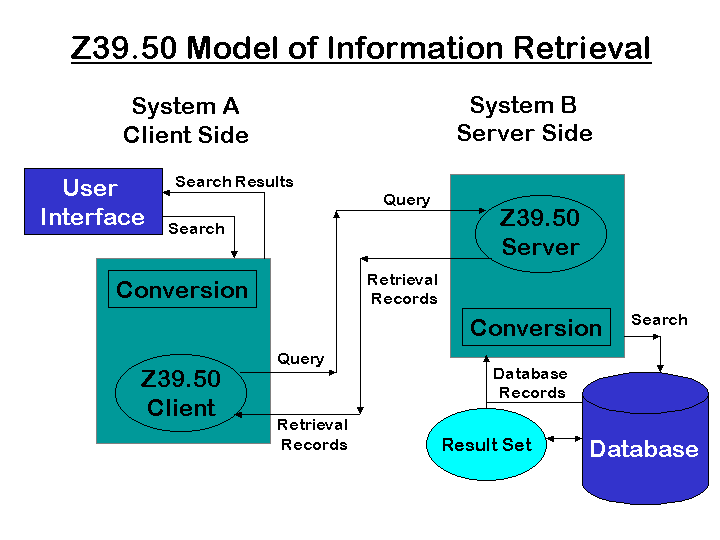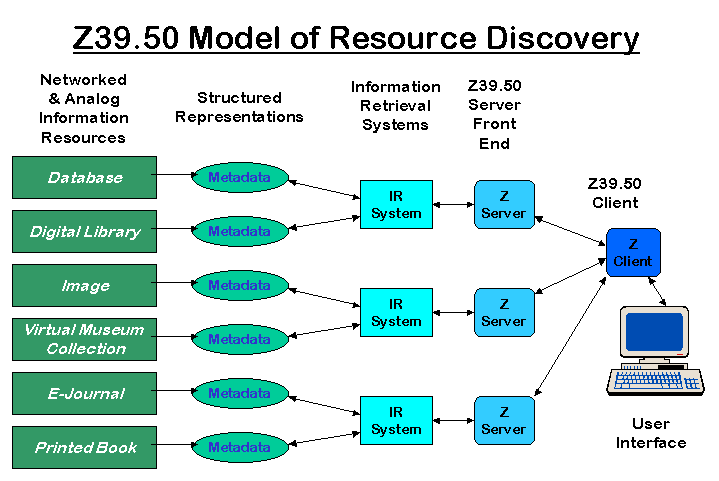This site is intended to be an introduction to the Z39.50 standard. Information for this site has been compiled from various sources.
Z39.50 is the solution, so what's the problem. If you've ever tried to search on various databases -- electronic, library catalogs, etc. -- you've had to struggle with learning and using various interfaces to access each database. Z39.50 enables multiple diverse databases to be searched from the same interface. Also, if you don't know how data is indexed in the databases, your searching strategy can be affected. Z39.50 in combination with various profiles can assist with this difficulty as well.
"Z39.50 is a computer-to-computer communications protocol designed to support searching and retrieval of information -- full text documents, bibliographic data, images, multimedia -- in a distributed network environment." (William E. Moen, 1995)
This protocol allows a patron to use a computer program ("a client") to submit an information request to multiple computer database servers without having to know how to search on each of the different databases. The client can then compile the results from the various servers and present them to the patron.


Z39.50 acts as a translator between the "language" of the client and the "language" of the server.
Images used with permission of William E. Moen.
When discussing or reading about Z39.50, you need to know if you are talking about the client or the server. For example, if a vender tells you that you are purchasing Z39.50, does that mean that you are receiving a Z39.50 server or client or both?
| What Z Is | What Z Is Not |
|---|---|
| A computer-to-computer protocol | A database language |
| A "language" for communication | A search engine |
| A mechanism to search multiple databases at the same time | Search commands |
| A mechanism to retrieve records and have them displayed as if they were on a local system | A client interface |
"The essential power of Z39.50 is that it allows diverse information resources to look and act the same to the individual user." (Sebastian Hammer and John Favaro)
Z39.50 can help a library in many ways, but with the opportunities provided also come challenges. Some of these are listed below:
| Opportunities | Challenges |
|---|---|
| Enables a single interface for information retrieval -- choose a client carefully | With sophistication comes complexity |
| Enables access to multiple, diverse databases, not just online library databases | Z39.50 is misunderstood and is invisible to most users |
| Supports simple and sophisticated searching | Unrealistic expectations |
| Allows flexible and customizable retrieval | Differences in implementations -- see "Profiles" below |
| Benefits | Drawbacks |
| Patrons will have easier access to information outside of the local library | Costs -- check on grants |
| Access is given to multiple databases through one interface | Complexity: for configuration, an understanding of both the library database and the server is needed |
| Access is given to multiple types of data through one interface | Increased visibility and use |
| Can easily create a "union" catalog |
REMEMBER: The patron has no knowledge of this composition. The patron enters information as requested by the client; the client composes the Z39.50 search query. The patron may only have to enter a name and click "Author Search."
| Attribute | Value | Meaning |
|---|---|---|
| Use (1) | 1003 | Author |
| Relation (2) | 3 | Equal to |
| Structure (4) | 1 | Search term is a phrase |
| Truncation (5) | 100 | Do not truncate |
Translation: 1=1003 2=3 4=1 5=100 "Twain, Mark"
If we change the search to an "Author-name Personal" and include right truncation, the query becomes:
Translation: 1=1004 2=3 4=1 5=1 "Twain, Mark"
Since much of the Z39.50 standard allows for options, software vendors may implement the standard in somewhat different ways and still be "Z39.50 compliant." Also, differences in the way the database is created (indexed) can lead to results that are not consistent. Some examples of things to consider:
Funded by a grant from the Institute of Museum and Library Services, the University of North Texas, School of Library and Information Sciences and Texas Center for Digital Knowledge are working to create an interoperability testbed. "The project, Realizing the Vision of Networked Access to Library Resources: An Applied Research and Demonstration Project to Establish and Operate a Z39.50 Interoperability Testbed, will design and demonstrate test methods and metrics to assess interoperability between systems using the ANSI/NISO Z39.50 standard protocol for information retrieval. The overall goal for the project is to improve Z39.50 semantic interoperability among libraries for information access and resource sharing." -- from the project web site
This site was compiled by Mike Pullin. Please send comments, suggestions, and corrections to mike@txmike.com.
Last updated: September 29, 2004.